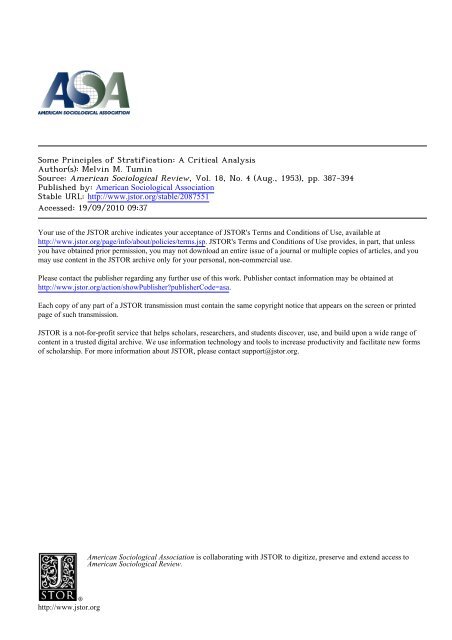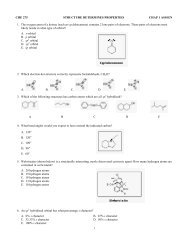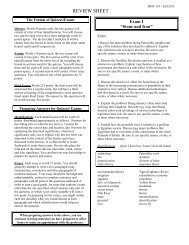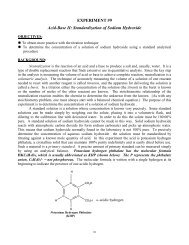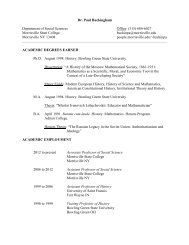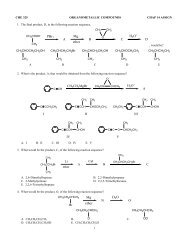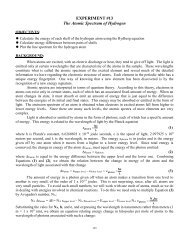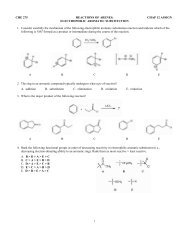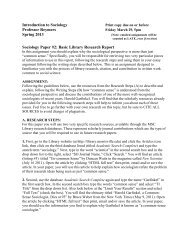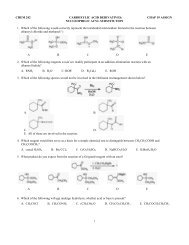Some Principles of Stratification - Theories of Social Differentiation ...
Some Principles of Stratification - Theories of Social Differentiation ...
Some Principles of Stratification - Theories of Social Differentiation ...
Create successful ePaper yourself
Turn your PDF publications into a flip-book with our unique Google optimized e-Paper software.
<strong>Some</strong> <strong>Principles</strong> <strong>of</strong> <strong>Stratification</strong>: A Critical Analysis<br />
Author(s): Melvin M. Tumin<br />
Source: American Sociological Review, Vol. 18, No. 4 (Aug., 1953), pp. 387-394<br />
Published by: American Sociological Association<br />
Stable URL: http://www.jstor.org/stable/2087551<br />
Accessed: 19/09/2010 09:37<br />
Your use <strong>of</strong> the JSTOR archive indicates your acceptance <strong>of</strong> JSTOR's Terms and Conditions <strong>of</strong> Use, available at<br />
http://www.jstor.org/page/info/about/policies/terms.jsp. JSTOR's Terms and Conditions <strong>of</strong> Use provides, in part, that unless<br />
you have obtained prior permission, you may not download an entire issue <strong>of</strong> a journal or multiple copies <strong>of</strong> articles, and you<br />
may use content in the JSTOR archive only for your personal, non-commercial use.<br />
Please contact the publisher regarding any further use <strong>of</strong> this work. Publisher contact information may be obtained at<br />
http://www.jstor.org/action/showPublisherpublisherCode=asa.<br />
Each copy <strong>of</strong> any part <strong>of</strong> a JSTOR transmission must contain the same copyright notice that appears on the screen or printed<br />
page <strong>of</strong> such transmission.<br />
JSTOR is a not-for-pr<strong>of</strong>it service that helps scholars, researchers, and students discover, use, and build upon a wide range <strong>of</strong><br />
content in a trusted digital archive. We use information technology and tools to increase productivity and facilitate new forms<br />
<strong>of</strong> scholarship. For more information about JSTOR, please contact support@jstor.org.<br />
American Sociological Association is collaborating with JSTOR to digitize, preserve and extend access to<br />
American Sociological Review.<br />
http://www.jstor.org
SOME PRINCIPLES OF STRATIFICATION: A CRITICAL<br />
ANALYSIS *<br />
MELVIN M. TUMIN<br />
Princeton University<br />
T HE fact <strong>of</strong> social inequality in human<br />
society is marked by its ubiquity and<br />
its antiquity. Every known society,<br />
past and present, distributes its scarce and<br />
demanded goods and services unequally.<br />
And there are attached to the positions<br />
which command unequal amounts <strong>of</strong> such<br />
goods and services certain highly morallytoned<br />
evaluations <strong>of</strong> their importance for<br />
the society.<br />
The ubiquity and the antiquity <strong>of</strong> such<br />
inequality has given rise to the assumption<br />
that there must be something both inevitable<br />
and positively functional about such social<br />
arrangements.<br />
Clearly, the truth or falsity <strong>of</strong> such an<br />
assumption is a strategic question for any<br />
general theory <strong>of</strong> social organization. It is<br />
therefore most curious that the basic premises<br />
and implications <strong>of</strong> the assumption have<br />
only been most casually explored by American<br />
sociologists.<br />
The most systematic treatment is to be<br />
found in the well-known article by Kingsley<br />
Davis and Wilbert Moore, entitled "<strong>Some</strong><br />
<strong>Principles</strong> <strong>of</strong> <strong>Stratification</strong>." 1 More than<br />
* The writer has had the benefit <strong>of</strong> a most<br />
helpful criticism <strong>of</strong> the main portions <strong>of</strong> this paper<br />
by Pr<strong>of</strong>essor W. J. Goode <strong>of</strong> Columbia University.<br />
In addition, he has had the opportunity to expose<br />
this paper to criticism by the Staff Seminar <strong>of</strong><br />
the Sociology Section at Princeton. In deference<br />
to a possible rejoinder by Pr<strong>of</strong>essors Moore and<br />
Davis, the writer has not revised the paper to<br />
meet the criticisms which Moore has already<br />
<strong>of</strong>fered personally.<br />
' American Sociological Review, X (April,<br />
1945), pp. 242-249. An earlier article by Kingsley<br />
Davis, entitled, "A Conceptual Analysis <strong>of</strong> <strong>Stratification</strong>,"<br />
American Sociological Review, VII<br />
(June, 1942), pp. 309-321, is devoted primarily to<br />
setting forth a vocabulary for stratification analysis.<br />
A still earlier article by Talcott Parsons, "An<br />
Analytical Approach to the Theory <strong>of</strong> <strong>Social</strong> Strati-<br />
fication," American Journal <strong>of</strong> Sociology, XLV<br />
(November, 1940), pp. 849-862, approaches the<br />
problem in terms <strong>of</strong> why "differential ranking is<br />
considered a really fundamental phenomenon <strong>of</strong><br />
social systems and what are the respects in which<br />
such ranking is important." The principal line <strong>of</strong><br />
twelve years have passed since its publication,<br />
and though it is one <strong>of</strong> the very few<br />
treatments <strong>of</strong> stratification on a high level<br />
<strong>of</strong> generalization, it is difficult to locate a<br />
single systematic analysis <strong>of</strong> its reasoning.<br />
It will be the principal concern <strong>of</strong> this paper<br />
to present the beginnings <strong>of</strong> such an analysis.<br />
The central argument advanced by Davis<br />
and Moore can be stated in a number <strong>of</strong><br />
sequential propositions, as follows:<br />
(1) Certain positions in any society are functionally<br />
more important than others,<br />
and require special skills for their<br />
performance.<br />
(2) Only a limited number <strong>of</strong> individuals<br />
in any society have the talents which<br />
can be trained into the skills appropriate<br />
to these positions.<br />
(3) The conversion <strong>of</strong> talents into skills involves<br />
a training period during which<br />
sacrifices <strong>of</strong> one kind or another are<br />
made by those undergoing the training.<br />
(4) In order to induce the talented persons<br />
to undergo these sacrifices and acquire<br />
the training, their future positions must<br />
carry an inducement value in the form<br />
<strong>of</strong> differential, i.e., privileged and disproportionate<br />
access to the scarce and desired<br />
rewards which the society has to<br />
<strong>of</strong>fer.2<br />
(5) These scarce and desired goods consist<br />
<strong>of</strong> the rights and perquisites attached to,<br />
integration asserted by Parsons is with the fact<br />
<strong>of</strong> the normative orientation <strong>of</strong> any society. Certain<br />
crucial lines <strong>of</strong> connection are left unexplained,<br />
however, in this article, and in the Davis and<br />
Moore article <strong>of</strong> 1945 only some <strong>of</strong> these lines<br />
are made explicit.<br />
2 The "scarcity and demand" qualities <strong>of</strong> goods<br />
and services are never explicitly mentioned by<br />
Davis and Moore. But it seems to the writer that<br />
the argument makes no sense unless the goods<br />
and services are so characterized. For if rewards<br />
are to function as differential inducements they<br />
must not only be differentially distributed but they<br />
must be both scarce and demanded as well. Neither<br />
the scarcity <strong>of</strong> an item by itself nor the fact <strong>of</strong><br />
its being in demand is sufficient to allow it to<br />
function as a differential inducement in a system<br />
<strong>of</strong> unequal rewards. Leprosy is scarce and oxygen<br />
is highly demanded.<br />
387
388 AMERICAN SOCIOLOGICAL REVIEW<br />
or built into, the positions, and can be<br />
classified into those things which contribute<br />
to (a) sustenance and comfort,<br />
(b) humor and diversion, (c) self-respect<br />
and ego expansion.<br />
(6) This differential access to the basic rewards<br />
<strong>of</strong> the society has as a consequence<br />
the differentiation <strong>of</strong> the prestige<br />
and esteem which various strata acquire.<br />
This may be said, along with the rights<br />
and perquisites, to constitute institution-<br />
alized social inequality, i.e., stratification.<br />
(7) Therefore, social inequality among different<br />
strata in the amounts <strong>of</strong> scarce<br />
and desired goods, and the amounts <strong>of</strong><br />
prestige and esteem which they receive,<br />
is both positively functional and inevitable<br />
in any society.<br />
Let us take these propositions and examine<br />
them seriatim..3<br />
(1) Certain positions in any society are<br />
more functionally important than others and<br />
require special skills for their performance.<br />
The key term here is "functionally important."<br />
The functionalist theory <strong>of</strong> social<br />
organization is by no means clear and explicit<br />
about this term. The minimum common<br />
referent is to something known as the<br />
"survival value" <strong>of</strong> a social structure.4 This<br />
concept immediately involves a number <strong>of</strong><br />
perplexing questions. Among these are: (a)<br />
the issue <strong>of</strong> minimum vs. maximum survival,<br />
and the possible empirical referents which<br />
can be given to those terms; (b) whether<br />
such a proposition is a useless tautology<br />
since any status quo at any given moment<br />
is nothing more and nothing less than everything<br />
present in the status quo. In these<br />
terms, all acts and structures must be judged<br />
positively functional in that they constitute<br />
essential portions <strong>of</strong> the status quo; (c)<br />
what kind <strong>of</strong> calculus <strong>of</strong> functionality exists<br />
which will enable us, at this point in our<br />
development, to add and subtract long and<br />
short range consequences, with their mixed<br />
qualities, and arrive at some summative<br />
3 The arguments to be advanced here are condensed<br />
versions <strong>of</strong> a much longer analysis entitled,<br />
An Essay on <strong>Social</strong> <strong>Stratification</strong>. Perforce, all the<br />
reasoning necessary to support some <strong>of</strong> the contentions<br />
cannot be <strong>of</strong>fered within the space limits<br />
<strong>of</strong> this article.<br />
4 Davis and Moore are explicitly aware <strong>of</strong> the<br />
difficulties involved here and suggest two "independent<br />
clues" other than survival value. See footnote<br />
3 on p. 244 <strong>of</strong> their article.<br />
judgment regarding the rating an act or<br />
structure should receive on a scale <strong>of</strong> greater<br />
or lesser functionality At best, we tend to<br />
make primarily intuitive judgments. Often<br />
enough, these judgments involve the use <strong>of</strong><br />
value-laden criteria, or, at least, criteria<br />
which are chosen in preference to others<br />
not for any sociologically systematic reasons<br />
but by reason <strong>of</strong> certain implicit value<br />
preferences.<br />
Thus, to judge that the engineers in a<br />
factory are functionally more important to<br />
the factory than the unskilled workmen involves<br />
a notion regarding the dispensability<br />
<strong>of</strong> the unskilled workmen, or their replaceability,<br />
relative to that <strong>of</strong> the engineers. But<br />
this is not a process <strong>of</strong> choice with infinite<br />
time dimensions. For at some point along<br />
the line one must face the problem <strong>of</strong> adequate<br />
motivation for all workers at all levels<br />
<strong>of</strong> skill in the factory. In the long run,<br />
some labor force <strong>of</strong> unskilled workmen is<br />
as important and as indispensable to the<br />
factory as some labor force <strong>of</strong> engineers.<br />
Often enough, the labor force situation is<br />
such that this fact is brought home sharply<br />
to the entrepreneur in the short run rather<br />
than in the long run.<br />
Moreover, the judgment as to the relative<br />
indispensability and replaceability <strong>of</strong> a<br />
particular segment <strong>of</strong> skills in the population<br />
involves a prior judgment about the bargaining-power<br />
<strong>of</strong> that segment. But this<br />
power is itself a culturally shaped consequence<br />
<strong>of</strong> the existing system <strong>of</strong> rating,<br />
rather than something inevitable in the nature<br />
<strong>of</strong> social organization. At least the contrary<br />
<strong>of</strong> this has never been demonstrated,<br />
but only assumed.<br />
A generalized theory <strong>of</strong> social stratification<br />
must recognize that the prevailing system<br />
<strong>of</strong> inducements and rewards is only one<br />
<strong>of</strong> many variants in the whole range <strong>of</strong><br />
possible systems <strong>of</strong> motivation which, at<br />
least theoretically, are capable <strong>of</strong> working<br />
in human society. It is quite conceivable, <strong>of</strong><br />
course, that a system <strong>of</strong> norms could be<br />
institutionalized in which the idea <strong>of</strong> threatened<br />
withdrawal <strong>of</strong> services, except under<br />
the most extreme circumstances, would be<br />
considered as absolute moral anathema. In<br />
such a case, the whole notion <strong>of</strong> relative<br />
functionality, as advanced by Davis and<br />
Moore, would have to be radically revised.<br />
(2) Only a limited number <strong>of</strong> individuals
SOME PRINCIPLES OF STRATIFICATION 389<br />
in any society have the talents which can<br />
be trained into the skills appropriate to these<br />
positions (i.e., the more functionally important<br />
positions).<br />
The truth <strong>of</strong> this proposition depends at<br />
least in part on the truth <strong>of</strong> proposition 1<br />
above. It is, therefore, subject to all the<br />
limitations indicated above. But for the moment,<br />
let us assume the validity <strong>of</strong> the first<br />
proposition and concentrate on the question<br />
<strong>of</strong> the rarity <strong>of</strong> appropriate talent.<br />
If all that is meant is that in every society<br />
there is a range <strong>of</strong> talent, and that<br />
some members <strong>of</strong> any society are by nature<br />
more talented than others, no sensible contradiction<br />
can be <strong>of</strong>fered, but a question<br />
must be raised here regarding the amount<br />
<strong>of</strong> sound knowledge present in any society<br />
concerning the presence <strong>of</strong> talent in the<br />
population.<br />
For, in every society there is some demonstrable<br />
ignorance regarding the amount<br />
<strong>of</strong> talent present in the population. And the<br />
more rigidly stratified a society is, the less<br />
chance does that society have <strong>of</strong> discovering<br />
any new facts about the talents <strong>of</strong> its<br />
members. Smoothly working and stable systems<br />
<strong>of</strong> stratification, wherever found, tend<br />
to build-in obstacles to the further exploration<br />
<strong>of</strong> the range <strong>of</strong> available talent. This<br />
is especially true in those societies where<br />
the opportunity to discover talent in any<br />
one generation varies with the differential<br />
resources <strong>of</strong> the parent generation. Where,<br />
for instance, access to education depends<br />
upon the wealth <strong>of</strong> one's parents, and where<br />
wealth is differentially distributed, large segments<br />
<strong>of</strong> the population are likely to be<br />
deprived <strong>of</strong> the chance even to discover what<br />
are their talents.<br />
Whether or not differential rewards and<br />
opportunities are functional in any one generation,<br />
it is clear that if those differentials<br />
are allowed to be socially inherited by the<br />
next generation, then, the stratification system<br />
is specifically dysfunctional for the discovery<br />
<strong>of</strong> talents in the next generation. In<br />
this fashion, systems <strong>of</strong> social stratification<br />
tend to limit the chances available to maximize<br />
the efficiency <strong>of</strong> discovery, recruitment<br />
and training <strong>of</strong> "functionally important<br />
talent." r<br />
5Davis and Moore state this point briefly on<br />
p. 248 but do not elaborate it.<br />
Additionally, the unequal distribution <strong>of</strong><br />
rewards in one generation tends to result in<br />
the unequal distribution <strong>of</strong> motivation in the<br />
succeeding generation. Since motivation to<br />
succeed is clearly an important element in<br />
the entire process <strong>of</strong> education, the unequal<br />
distribution <strong>of</strong> motivation tends to set limits<br />
on the possible extensions <strong>of</strong> the educational<br />
system, and hence, upon the efficient recruitment<br />
and training <strong>of</strong> the widest body <strong>of</strong><br />
skills available in the population."<br />
Lastly, in this context, it may be asserted<br />
that there is some noticeable tendency for<br />
elites to restrict further access to their privileged<br />
positions, once they have sufficient<br />
power to enforce such restrictions. This is<br />
especially true in a culture where it is possible<br />
for an elite to contrive a high demand<br />
and a proportionately higher reward for its<br />
work by restricting the numbers <strong>of</strong> the elite<br />
available to do the work. The recruitment<br />
and training <strong>of</strong> doctors in modern United<br />
States is at least partly a case in point.<br />
Here, then, are three ways, among others<br />
which could be cited, in which stratification<br />
systems, once operative, tend to reduce the<br />
survival value <strong>of</strong> a society by limiting the<br />
search, recruitment and training <strong>of</strong> functionally<br />
important personnel far more<br />
sharply than the facts <strong>of</strong> available talent<br />
would appear to justify. It is only when<br />
there is genuinely equal access to recruitment<br />
and training for all potentially talented<br />
persons that differential rewards can conceivably<br />
be justified as functional. And<br />
stratification systems are apparently inherently<br />
antagonistic to the development <strong>of</strong><br />
such full equality <strong>of</strong> opportunity.<br />
(3) The conversion <strong>of</strong> talents into skills<br />
involves a training period during which sacrifices<br />
<strong>of</strong> one kind or another are made by<br />
those undergoing the training.<br />
Davis and Moore introduce here a concept,<br />
"sacrifice" which comes closer than<br />
any <strong>of</strong> the rest <strong>of</strong> their vocabulary <strong>of</strong> analysis<br />
to being a direct reflection <strong>of</strong> the ration-<br />
6<br />
In the United States, for instance, we are<br />
only now becoming aware <strong>of</strong> the amount <strong>of</strong> productivity<br />
we, as a society, lose by allocating inferior<br />
opportunities and rewards, and hence, inferior motivation,<br />
to our Negro population. The actual amount<br />
<strong>of</strong> loss is difficult to specify precisely. <strong>Some</strong> rough<br />
estimate can be made, however, on the assumption<br />
that there is present in the Negro population<br />
about the same range <strong>of</strong> talent that is found in<br />
the White population.
390 AMERICAN SOCIOLOGICAL REVIEW<br />
alizations, <strong>of</strong>fered by the more fortunate<br />
members <strong>of</strong> a society, <strong>of</strong> the rightness <strong>of</strong><br />
their occupancy <strong>of</strong> privileged positions. It<br />
is the least critically thought-out concept in<br />
the repertoire, and can also be shown to be<br />
least supported by the actual facts.<br />
In our present society, for example, what<br />
are the sacrifices which talented persons<br />
undergo in the training period The possibly<br />
serious losses involve the surrender <strong>of</strong><br />
earning power and the cost <strong>of</strong> the training.<br />
The latter is generally borne by the parents<br />
<strong>of</strong> the talented youth undergoing training,<br />
and not by the trainees themselves. But this<br />
cost tends to be paid out <strong>of</strong> income which<br />
the parents were able to earn generally by<br />
virtue <strong>of</strong> their privileged positions in the<br />
hierarchy <strong>of</strong> stratification. That is to say,<br />
the parents' ability to pay for the training<br />
<strong>of</strong> their children is part <strong>of</strong> the differential<br />
reward they, the parents, received for their<br />
privileged positions in the society. And to<br />
charge this sum up against sacrifices made<br />
by the youth is falsely to perpetrate a bill<br />
or a debt already paid by the society to<br />
the parents.<br />
So far as the sacrifice <strong>of</strong> earning power<br />
by the trainees themselves is concerned, the<br />
loss may be measured relative to what they<br />
might have earned had they gone into the<br />
labor market instead <strong>of</strong> into advanced training<br />
for the "important" skills. There are<br />
several ways to judge this. One way is to<br />
take all the average earnings <strong>of</strong> age peers<br />
who did go into the labor market for a<br />
period equal to the average length <strong>of</strong> the<br />
training period. The total income, so calculated,<br />
roughly equals an amount which<br />
the elite can, on the average, earn back<br />
in the first decade <strong>of</strong> pr<strong>of</strong>essional work, over<br />
and above the earnings <strong>of</strong> his age peers who<br />
are not trained. Ten years is probably the<br />
maximum amount needed to equalize the<br />
differential.7 There remains, on the average,<br />
twenty years <strong>of</strong> work during each <strong>of</strong> which<br />
the skilled person then goes on to earn far<br />
more than his unskilled age peers. And,<br />
what is <strong>of</strong>ten forgotten, there is then still<br />
another ten or fifteen year period during<br />
which the skilled person continues to work<br />
and earn when his unskilled age peer is<br />
7 These are only very rough estimates, <strong>of</strong> course,<br />
and it is certain that there is considerable income<br />
variation within the so-called elite group. so that<br />
the proposition holds only relatively more or less.<br />
either totally or partially out <strong>of</strong> the labor<br />
market by virtue <strong>of</strong> the attrition <strong>of</strong> his<br />
strength and capabilities.<br />
One might say that the first ten years<br />
<strong>of</strong> differential pay is perhaps justified, in<br />
order to regain for the trained person what<br />
he lost during his training period. But it<br />
is difficult to imagine what would justify<br />
continuing such differential rewards beyond<br />
that period.<br />
Another and probably sounder way to<br />
measure how much is lost during the training<br />
period is to compare the per capita<br />
income available to the trainee with the per<br />
capita income <strong>of</strong> the age peer on the untrained<br />
labor market during the so-called<br />
sacrificial period. If one takes into account<br />
the earlier marriage <strong>of</strong> untrained persons,<br />
and the earlier acquisition <strong>of</strong> family dependents,<br />
it is highly dubious that the per capita<br />
income <strong>of</strong> the wage worker is significantly<br />
larger than that <strong>of</strong> the trainee. Even assuming,<br />
for the moment, that there is a<br />
difference, the amount is by no means sufficient<br />
to justify a lifetime <strong>of</strong> continuing<br />
differentials.<br />
What tends to be completely overlooked,<br />
in addition, are the psychic and spiritual<br />
rewards which are available to the elite<br />
trainees by comparison with their age peers<br />
in the labor force. There is, first, the much<br />
higher prestige enjoyed by the college student<br />
and the pr<strong>of</strong>essional-school student as<br />
compared with persons in shops and <strong>of</strong>fices.<br />
There is, second, the extremely highly valued<br />
privilege <strong>of</strong> having greater opportunity<br />
for self-development. There is, third, all the<br />
psychic gain involved in being allowed to<br />
delay the assumption <strong>of</strong> adult responsibilities<br />
such as earning a living and supporting<br />
a family. There is, fourth, the access to<br />
leisure and freedom <strong>of</strong> a kind not likely<br />
to be experienced by the persons already at<br />
work.<br />
If these are never taken into account as<br />
rewards <strong>of</strong> the training period it is not<br />
because they are not concretely present, but<br />
because the emphasis in American concepts<br />
<strong>of</strong> reward is almost exclusively placed on<br />
the material returns <strong>of</strong> positions. The emphases<br />
on enjoyment, entertainment, ego<br />
enhancement, prestige and esteem are introduced<br />
only when the differentials in these<br />
which accrue to the skilled positions need<br />
to be justified. If these other rewards were
SOME PRINCIPLES OF STRATIFICATION 391<br />
taken into account, it would be much more<br />
difficult to demonstrate that the training<br />
period, as presently operative, is really sacrificial.<br />
Indeed, it might turn out to be the<br />
case that even at this point in their careers,<br />
the elite trainees were being differentially<br />
rewarded relative to their age peers in the<br />
labor force.<br />
All <strong>of</strong> the foregoing concerns the quality<br />
<strong>of</strong> the training period under our present<br />
system <strong>of</strong> motivation and rewards. Whatever<br />
may turn out to be the factual case about<br />
the present system-and the factual case<br />
is moot-the more important theoretical<br />
question concerns the assumption that the<br />
training period under any system must be<br />
sacrificial.<br />
There seem to be no good theoretical<br />
grounds for insisting on this assumption.<br />
For, while under any system certain costs<br />
will be involved in training persons for<br />
skilled positions, these costs could easily be<br />
assumed by the society-at-large. Under these<br />
circumstances, there would be no need to<br />
compensate anyone in terms <strong>of</strong> differential<br />
rewards once the skilled positions were<br />
staffed. In short, there would be no need<br />
or justification for stratifying social positions<br />
on these grounds.<br />
(4) In order to induce the talented persons<br />
to undergo these sacrifices and acquire<br />
the training, their future positions must<br />
carry an inducement value in the form <strong>of</strong><br />
differential, i.e., privileged and disproportionate<br />
access to the scarce and desired rewards<br />
which the society has to <strong>of</strong>fer.<br />
Let us assume, for the purposes <strong>of</strong> the<br />
discussion, that the training period is sacrificial<br />
and the talent is rare in every conceivable<br />
human society. There is still the<br />
basic problem as to whether the allocation<br />
<strong>of</strong> differential rewards in scarce and desired<br />
goods and services is the only or the most<br />
efficient way <strong>of</strong> recruiting the appropriate<br />
talent to these positions.<br />
For there are a number <strong>of</strong> alternative motivational<br />
schemes whose efficiency and adequacy<br />
ought at least to be considered in<br />
this context. What can be said, for instance,<br />
on behalf <strong>of</strong> the motivation which De Man<br />
called "joy in work," Veblen termed "instinct<br />
for workmanship" and which we latterly<br />
have come to identify as "intrinsic<br />
work satisfaction" Or, to what extent could<br />
the motivation <strong>of</strong> "social duty" be institu-<br />
tionalized in such a fashion that self interest<br />
and social interest come closely to coincide<br />
Or, how much prospective confidence can<br />
be placed in the possibilities <strong>of</strong> institutionalizing<br />
"social service" as a widespread motivation<br />
for seeking one's appropriate position<br />
and fulfilling it conscientiously<br />
Are not these types <strong>of</strong> motivations, we<br />
may ask, likely to prove most appropriate<br />
for precisely the "most functionally important<br />
positions" Especially in a mass industrial<br />
society, where the vast majority <strong>of</strong><br />
positions become standardized and routinized,<br />
it is the skilled jobs which are likely<br />
to retain most <strong>of</strong> the quality <strong>of</strong> "intrinsic<br />
job satisfaction" and be most readily identifiable<br />
as socially serviceable. Is it indeed<br />
impossible then to build these motivations<br />
into the socialization pattern to which we<br />
expose our talented youth<br />
To deny that such motivations could be<br />
institutionalized would be to overclaim our<br />
present knowledge. In part, also, such a<br />
claim would seem to deprive from an assumption<br />
that what has not been institutionalized<br />
yet in human affairs is incapable<br />
<strong>of</strong> institutionalization. Admittedly, historical<br />
experience affords us evidence we cannot<br />
afford to ignore. But such evidence cannot<br />
legitimately be used to deny absolutely the<br />
possibility <strong>of</strong> heret<strong>of</strong>ore untried alternatives.<br />
<strong>Social</strong> innovation is as important a feature<br />
<strong>of</strong> human societies as social stability.<br />
On the basis <strong>of</strong> these observations, it<br />
seems that Davis and Moore have stated the<br />
case much too strongly when they insist that<br />
a "functionally important position" which<br />
requires skills that are scarce, "must command<br />
great prestige, high salary, ample<br />
leisure, and the like," if the appropriate<br />
talents are to be attracted to the position.<br />
Here, clearly, the authors are postulating<br />
the unavoidability <strong>of</strong> very specific types <strong>of</strong><br />
rewards and, by implication, denying the<br />
possibility <strong>of</strong> others.<br />
(5) These scarce and desired goods consist<br />
<strong>of</strong> rights and perquisites attached to,<br />
or built into, the positions and can be classified<br />
into those things which contribute to<br />
(a) sustenance and comfort; (b) humor<br />
and diversion; (c) self respect and ego<br />
expansion.<br />
(6) This differential access to the basic<br />
rewards <strong>of</strong> the society has as a consequence<br />
the differentiation <strong>of</strong> the prestige and esteem
392 AMERICAN SOCIOLOGICAL REVIEW<br />
which various strata acquire. This may be<br />
said, along with the rights and perquisites,<br />
to constitute institutionalized social inequality,<br />
i.e., stratification.<br />
With the classification <strong>of</strong> the rewards<br />
<strong>of</strong>fered by Davis and Moore there need be<br />
little argument. <strong>Some</strong> question must be<br />
raised, however, as to whether any reward<br />
system, built into a general stratification<br />
system, must allocate equal amounts <strong>of</strong> all<br />
three types <strong>of</strong> reward in order to function<br />
effectively, or whether one type <strong>of</strong> reward<br />
may be emphasized to the virtual neglect<br />
<strong>of</strong> others. This raises the further question<br />
regarding which type <strong>of</strong> emphasis is likely<br />
to prove most effective as a differential inducer.<br />
Nothing in the known facts about<br />
human motivation impels us to favor one<br />
type <strong>of</strong> reward over the other, or to insist<br />
that all three types <strong>of</strong> reward must be built<br />
into the positions in comparable amounts<br />
if the position is to have an inducement<br />
value.<br />
It is well known, <strong>of</strong> course, that societies<br />
differ considerably in the kinds <strong>of</strong> rewards<br />
they emphasize in their efforts to maintain<br />
a reasonable balance between responsibility<br />
and reward. There are, for instance, numerous<br />
societies in which the conspicuous display<br />
<strong>of</strong> differential economic advantage is<br />
considered extremely bad taste. In short, our<br />
present knowledge commends to us the possibility<br />
<strong>of</strong> considerable plasticity in the way<br />
in which different types <strong>of</strong> rewards can be<br />
structured into a functioning society. This<br />
is to say, it cannot yet be demonstrated<br />
that it is unavoidable that differential prestige<br />
and esteem shall accrue to positions<br />
which command differential rewards in<br />
power and property.<br />
What does seem to be unavoidable is that<br />
differential prestige shall be given to those<br />
in any society who conform to the normative<br />
order as against those who deviate from<br />
that order in a way judged immoral and<br />
detrimental. On the assumption that the<br />
continuity <strong>of</strong> a society depends on the continuity<br />
and stability <strong>of</strong> its normative order,<br />
some such distinction between conformists<br />
and deviants seems inescapable.<br />
It also seems to be unavoidable that in<br />
any society, no matter how literate its tradition,<br />
the older, wiser and more experienced<br />
individuals who are charged with the en-<br />
culturation and socialization <strong>of</strong> the young<br />
must have more power than the young, on<br />
the assumption that the task <strong>of</strong> effective<br />
socialization demands such differential<br />
power.<br />
But this differentiation in prestige between<br />
the conformist and the deviant is by<br />
no means the same distinction as that between<br />
strata <strong>of</strong> individuals each <strong>of</strong> which<br />
operates within the normative order, and is<br />
composed <strong>of</strong> adults. The latter distinction,<br />
in the form <strong>of</strong> differentiated rewards and<br />
prestige between social strata is what Davis<br />
and Moore, and most sociologists, consider<br />
the structure <strong>of</strong> a stratification system. The<br />
former distinctions have nothing necessarily<br />
to do with the workings <strong>of</strong> such a system<br />
nor with the efficiency <strong>of</strong> motivation<br />
and recruitment <strong>of</strong> functionally important<br />
personnel.<br />
Nor does the differentiation <strong>of</strong> power between<br />
young and old necessarily create differentially<br />
valued strata. For no society rates<br />
its young as less morally worthy than its<br />
older persons, no matter how much differential<br />
power the older ones may temporarily<br />
enjoy.<br />
(7) Therefore, social inequality among<br />
different strata in the amounts <strong>of</strong> scarce and<br />
desired goods, and the amounts <strong>of</strong> prestige<br />
and esteem which they receive, is both positively<br />
functional and inevitable in any<br />
society.<br />
If the objections which have heret<strong>of</strong>ore<br />
been raised are taken as reasonable, then<br />
it may be stated that the only items which<br />
any society must distribute unequally are<br />
the power and property necessary for the<br />
performance <strong>of</strong> different tasks. If such differential<br />
power and property are viewed by<br />
all as commensurate with the differential<br />
responsibilities, and if they are culturally<br />
defined as resources and not as rewards,<br />
then, no differentials in prestige and esteem<br />
need follow.<br />
Historically, the evidence seems to be<br />
that every time power and property are distributed<br />
unequally, no matter what the cultural<br />
definition, prestige and esteem differentiations<br />
have tended to result as well.<br />
Historically, however, no systematic effort<br />
has ever been made, under propitious circumstances,<br />
to develop the tradition that<br />
each man is as socially worthy as all other<br />
men so long as he performs his appropriate
SOME PRINCIPLES OF STRATIFICATION 393<br />
tasks conscientiously. While such a tradition<br />
seems utterly utopian, no known facts<br />
in psychological or social science have yet<br />
demonstrated its impossibility or its dysfunctionality<br />
for the continuity <strong>of</strong> a society.<br />
The achievement <strong>of</strong> a full institutionalization<br />
<strong>of</strong> such a tradition seems far too<br />
remote to contemplate. <strong>Some</strong> successive approximations<br />
at such a tradition, however,<br />
are not out <strong>of</strong> the range <strong>of</strong> prospective social<br />
innovation.<br />
What, then, <strong>of</strong> the "positive functionality"<br />
<strong>of</strong> social stratification Are there<br />
other, negative, functions <strong>of</strong> institutionalized<br />
social inequality which can be identified, if<br />
only tentatively <strong>Some</strong> such dysfunctions <strong>of</strong><br />
stratification have already been suggested in<br />
the body <strong>of</strong> this paper. Along with others<br />
they may now be stated, in the form <strong>of</strong><br />
provisional assertions, as follows:<br />
(1) <strong>Social</strong> stratification systems function<br />
to limit the possibility <strong>of</strong> discovery <strong>of</strong> the<br />
full range <strong>of</strong> talent available in a society.<br />
This results from the fact <strong>of</strong> unequal access<br />
to appropriate motivation, channels <strong>of</strong> recruitment<br />
and centers <strong>of</strong> training.<br />
(2) In foreshortening the range <strong>of</strong> avail-<br />
able talent, social stratification systems function<br />
to set limits upon the possibility <strong>of</strong><br />
expanding the productive resources <strong>of</strong> the<br />
society, at least relative to what might be<br />
the case under conditions <strong>of</strong> greater equality<br />
<strong>of</strong> opportunity.<br />
(3) <strong>Social</strong> stratification systems function<br />
to provide the elite with the political power<br />
necessary to procure acceptance and dominance<br />
<strong>of</strong> an ideology which rationalizes the<br />
status quo, whatever it may be, as "logical,"<br />
"natural" and "morally right." In this manner,<br />
social stratification systems function as<br />
essentially conservative influences in the societies<br />
in which they are found.<br />
(4) <strong>Social</strong> stratification systems function<br />
to distribute favorable self-images unequally<br />
throughout a population. To the extent that<br />
such favorable self-images are requisite to<br />
the development <strong>of</strong> the creative potential inherent<br />
in men, to that extent stratification<br />
systems function to limit the development <strong>of</strong><br />
this creative potential.<br />
(5) To the extent that inequalities in social<br />
rewards cannot be made fully acceptable<br />
to the less privileged in a society, social<br />
stratification systems function to encourage<br />
hostility, suspicion and distrust among the<br />
various segments <strong>of</strong> a society and thus to<br />
limit the possibilities <strong>of</strong> extensive social<br />
integration.<br />
(6) To the extent that the sense <strong>of</strong> significant<br />
membership in a society depends on<br />
one's place on the prestige ladder <strong>of</strong> the<br />
society, social stratification systems function<br />
to distribute unequally the sense <strong>of</strong> significant<br />
membership in the population.<br />
(7) To the extent that loyalty to a society<br />
depends on a sense <strong>of</strong> significant membership<br />
in the society, social stratification systems<br />
function to distribute loyalty unequally in the<br />
population.<br />
(8) To the extent that participation and<br />
apathy depend upon the sense <strong>of</strong> significant<br />
membership in the society, social stratification<br />
systems function to distribute the<br />
motivation to participate unequally in a<br />
population.<br />
Each <strong>of</strong> the eight foregoing propositions<br />
contains implicit hypotheses regarding the<br />
consequences <strong>of</strong> unequal distribution <strong>of</strong> rewards<br />
in a society in accordance with some<br />
notion <strong>of</strong> the functional importance <strong>of</strong> various<br />
positions. These are empirical hypotheses,<br />
subject to test. They are <strong>of</strong>fered here<br />
only as exemplary <strong>of</strong> the kinds <strong>of</strong> consequences<br />
<strong>of</strong> social stratification which are<br />
not <strong>of</strong>ten taken into account in dealing with<br />
the problem. They should also serve to reinforce<br />
the doubt that social inequality is<br />
a device which is uniformly functional for<br />
the role <strong>of</strong> guaranteeing that the most<br />
important tasks in a society will be performed<br />
conscientiously by the most competent<br />
persons.<br />
The obviously mixed character <strong>of</strong> the<br />
functions <strong>of</strong> social inequality should come<br />
as no surprise to anyone. If sociology is<br />
sophisticated in any sense, it is certainly<br />
with regard to its awareness <strong>of</strong> the mixed<br />
nature <strong>of</strong> any social arrangement, when the<br />
observer takes into account long as well as<br />
short range consequences and latent as well<br />
as manifest dimensions.<br />
SUMMARY<br />
In this paper, an effort has been made<br />
to raise questions regarding the inevitability<br />
and positive functionality <strong>of</strong> stratification,<br />
or institutionalized social inequality in rewards,<br />
allocated in accordance with some<br />
notion <strong>of</strong> the greater and lesser functional<br />
importance <strong>of</strong> various positions. The possible<br />
alternative meanings <strong>of</strong> the concept<br />
"functional importance" has been shown to<br />
be one difficulty. The question <strong>of</strong> the
394 AMERICAN SOCIOLOGICAL REVIEW<br />
scarcity or abundance <strong>of</strong> available talent<br />
has been indicated as a principal source <strong>of</strong><br />
possible variation. The extent to which the<br />
period <strong>of</strong> training for skilled positions may<br />
reasonably be viewed as sacrificial has been<br />
called into question. The possibility has been<br />
suggested that very different types <strong>of</strong> motivational<br />
schemes might conceivably be made<br />
to function. The separability <strong>of</strong> differentials<br />
in power and property considered as resources<br />
appropriate to a task from such<br />
differentials considered as rewards for the<br />
performance <strong>of</strong> a task has also been suggested.<br />
It has also been maintained that<br />
differentials in prestige and esteem do not<br />
necessarily follow upon differentials in power<br />
and property when the latter are considered<br />
as appropriate resources rather than rewards.<br />
Finally, some negative functions, or<br />
dysfunctions, <strong>of</strong> institutionalized social inequality<br />
have been tentatively identified, revealing<br />
the mixed character <strong>of</strong> the outcome<br />
<strong>of</strong> social stratification, and casting doubt on<br />
the contention that<br />
<strong>Social</strong> inequality is thus an unconsciously<br />
evolved device by which societies insure that<br />
the most important positions are conscientiously<br />
filled by the most qualified persons.8<br />
8 Davis and Moore, op. cit., p. 243.<br />
REPLY<br />
KINGSLEY DAVIS<br />
Columbia University<br />
Tumin's critique, almost as long as the article<br />
it criticizes, is unfortunately intended not to<br />
supplement or amend the Davis-Moore theory<br />
but to prove it wrong. The critique also sets<br />
a bad example from the standpoint <strong>of</strong> methodology.<br />
Nevertheless, it does afford us a meager<br />
opportunity to clarify and extend the original<br />
discussion. The latter, limited to eight pages,<br />
was so brief a treatment <strong>of</strong> so big a subject<br />
that it had to ignore certain relevant topics<br />
and telescope others. In the process <strong>of</strong> answering<br />
Tumin, a partial emendation can now be<br />
made.<br />
GENERAL CONSIDERATIONS<br />
Our critic seems to labor under four major<br />
difficulties, two <strong>of</strong> a methodological and two <strong>of</strong><br />
a substantive character. First, he appears not<br />
so much interested in understanding institutionalized<br />
inequality as in getting rid <strong>of</strong> it.<br />
By insinuating that we are "justifying" such<br />
inequality, he falls into the usual error <strong>of</strong> regarding<br />
a causal explanation <strong>of</strong> something as<br />
a justification <strong>of</strong> it. He himself <strong>of</strong>fers no explanation<br />
for the universality <strong>of</strong> stratified inequality.<br />
He argues throughout his critique that<br />
stratification does not have to be, instead <strong>of</strong><br />
trying to understand why it is. Our interest,<br />
however, was only in the latter question. If<br />
Tumin had chosen to state our propositions in<br />
our own words rather than his, he could not<br />
have pictured us as concerned with the question<br />
<strong>of</strong> whether stratification is "avoidable."<br />
Second, Tumin confuses abstract, or theoretical,<br />
reasoning on the one hand with raw<br />
empirical generalizations on the other. Much<br />
<strong>of</strong> his critique accordingly rests on the fallacy<br />
<strong>of</strong> misplaced concreteness. Our article dealt<br />
with stratified inequality as a general property<br />
<strong>of</strong> social systems. It represented a high degree<br />
<strong>of</strong> abstraction, because there are obviously<br />
other aspects <strong>of</strong> society which in actuality affect<br />
the operation <strong>of</strong> the prestige element. It is<br />
therefore impossible to move directly from the<br />
kind <strong>of</strong> propositions we were making to descriptive<br />
propositions about, say, American society.<br />
Third, in concentrating on only one journal<br />
article, Tumin has ignored other theoretical<br />
contributions by the authors on stratification<br />
and on other relevant aspects <strong>of</strong> society. He<br />
has thus both misrepresented the theory and<br />
raised questions that were answered elsewhere.<br />
Fourth, by ignoring additions to the theory<br />
in other places, Tumin has failed to achieve<br />
consistency in his use <strong>of</strong> the concept "stratification."<br />
The first requirement, in this connection,<br />
is to distinguish between stratified and nonstratified<br />
statuses. One <strong>of</strong> the authors under<br />
attack has shown the difference to hinge on<br />
the family. "Those positions that may be combined<br />
in the same legitimate family-viz., positions<br />
based on sex, age, and kinship-do not<br />
form part <strong>of</strong> the system <strong>of</strong> stratification. On<br />
the other hand those positions that are socially<br />
prohibited from being combined in the same<br />
legal family-viz., different caste or class positions-constitute<br />
what we call stratification."'l<br />
This distinction is basic, but in addition it is<br />
necessary to realize that two different questions<br />
can be asked about stratified positions: (a)<br />
Why are different evaluations and rewards given<br />
1 Kingsley Davis, Human Society, New York:<br />
Macmillan, 1949, p. 364.


